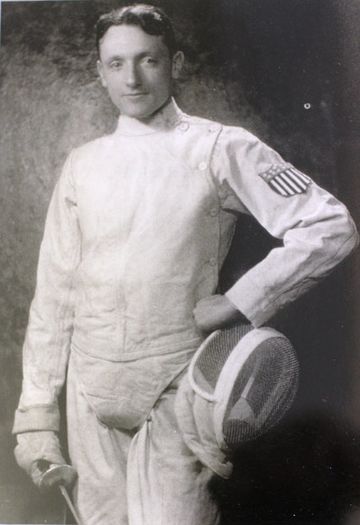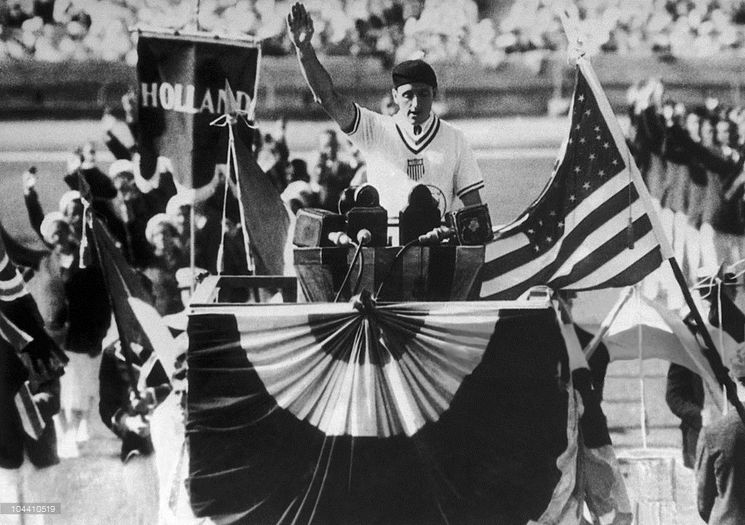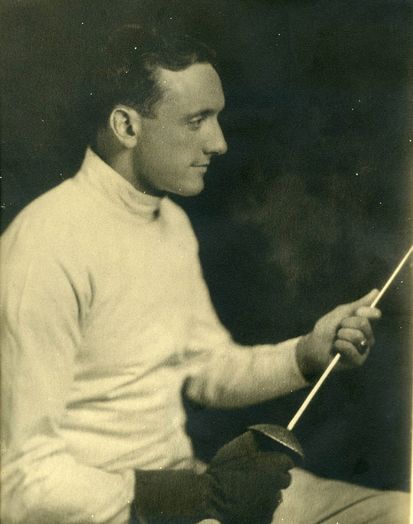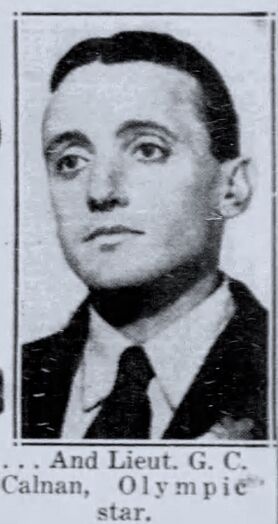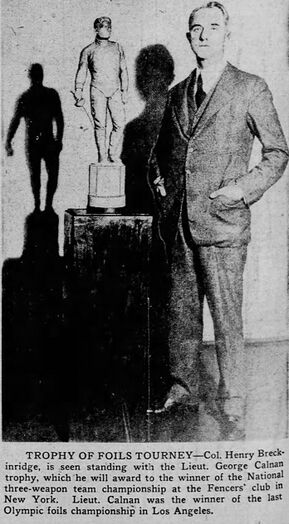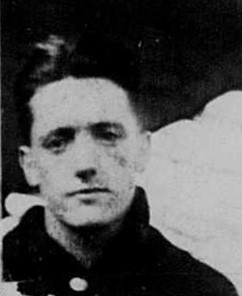GEORGE C. CALNAN, LT, USN
George Calnan '20
Lucky Bag
From the 1920 Lucky Bag:
George Charles Calnan
Boston, Massachusetts
IF you want to get the straight dope about George, just ask any Plebe in the Sixth company or in the Barracks and they will tell you all about him. In fact, his name and fame have spread far beyond his own deck;—George has gone in strong for the juvenile training stuff. But whenever you meet him he always comes down with this, "made a resolution to-day; am going to lay off the Plebes and treat 'em like brothers."
The Academic departments have always been ready to cry Kamerad to this Boston savior, and he takes their monthly offerings as a mental relaxation.
"Bilged cold, gentlemen, bilged cold, I tell you," is his standby after every exam, but he never gets less than a 3.4.
When "Cal" was a Plebe he was ever ready to catch us up for those little slips of language so common hereabouts. But a month on the U. S. S. Reina Mercedes slightly dulled his sensibilities.
"Oh, I just think that tall, handsome, black-haired boy from Massachusetts is splendid. Why doesn't he come to your hops more often?" This was on the occasion of his first and only appearance as a knight of the waxed floor, and the young lady spoke from her heart.
His Youngster year was spent in the old Eighth company, hence those diagonals at the start of First Class year.
However, sterling worth can not be hidden forever, so before many moons George was the proud possessor of a pair of buzzards.
Honors: Buzzard; Star, 3; Fencing fNt; Captain Fencing Team; Fencing Squad, 4, 3, 1; Academy Dueling Swords Champion, 3.
The Class of 1920 was graduated in June 1919 due to World War I. The entirety of 2nd class (junior) year was removed from the curriculum.
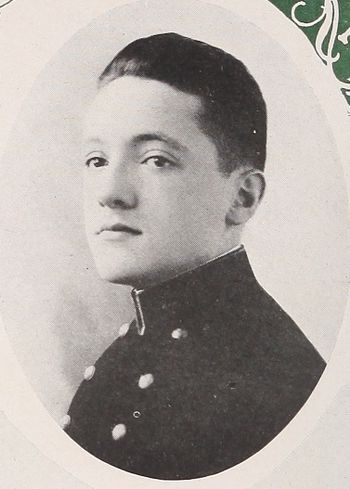
George Charles Calnan
Boston, Massachusetts
IF you want to get the straight dope about George, just ask any Plebe in the Sixth company or in the Barracks and they will tell you all about him. In fact, his name and fame have spread far beyond his own deck;—George has gone in strong for the juvenile training stuff. But whenever you meet him he always comes down with this, "made a resolution to-day; am going to lay off the Plebes and treat 'em like brothers."
The Academic departments have always been ready to cry Kamerad to this Boston savior, and he takes their monthly offerings as a mental relaxation.
"Bilged cold, gentlemen, bilged cold, I tell you," is his standby after every exam, but he never gets less than a 3.4.
When "Cal" was a Plebe he was ever ready to catch us up for those little slips of language so common hereabouts. But a month on the U. S. S. Reina Mercedes slightly dulled his sensibilities.
"Oh, I just think that tall, handsome, black-haired boy from Massachusetts is splendid. Why doesn't he come to your hops more often?" This was on the occasion of his first and only appearance as a knight of the waxed floor, and the young lady spoke from her heart.
His Youngster year was spent in the old Eighth company, hence those diagonals at the start of First Class year.
However, sterling worth can not be hidden forever, so before many moons George was the proud possessor of a pair of buzzards.
Honors: Buzzard; Star, 3; Fencing fNt; Captain Fencing Team; Fencing Squad, 4, 3, 1; Academy Dueling Swords Champion, 3.
The Class of 1920 was graduated in June 1919 due to World War I. The entirety of 2nd class (junior) year was removed from the curriculum.
Loss
George was lost when the airship USS Akron (ZRS 4) crashed off the coast of New Jersey on April 4, 1933.
Other Information
From researcher Kathy Franz:
George attended the Frederic W. Lincoln school and then graduated from English High school in 1915. Congressman James A. Gallivan nominated George as second alternate to the Naval Academy in March, 1916.
George represented the United States in the Olympics of 1920.
In the April, 1923, New England fencing championship, he won the foils championship. He came in second in the duelling sword contest and the saber contest.
His passport application in June, 1923, showed that he was going to England, Holland, France and Belgium. He was 6 feet tall with hazel eyes and dark brown hair. He had a large scar along his right arm.
George was the national foils champion for most of the years between 1925 and 1930.
In December, 1927, George was on board the steamship Penacook when he was summoned to the S4 disaster in Provincetown. Three special machines of German invention were sent from the Boston Navy Yard. The machines, called the “Inhabad,” could revive a suffocation victim even after 48 hours had elapsed. The victim’s arms were raised and lowered over the head at a breathing rate of 19 times per minute while oxygen was supplied through a mask fitting over the face. The heart was mechanically activated, and only George knew how to operate the machine.
In August, 1928, George competed in the individual epee championship competition at the Amsterdam Olympics finishing third.
On August 20, 1932, George married Lillian Collier in Swanton, Vermont. His best man was Col. Henry Breckenridge, a close friend of Charles A. Lindbergh.
In December that year, George was one of 10 finalists out of 100 nominees for the Sullivan memorial award. It was given annually by the Amateur Athletic Union to the athlete representing the highest ideals and attainment in amateur athletics.
On April 7, 1933, members of his high school cadet corps paid tribute to George at their annual prize drill.
A fencing trophy was named in George’s honor that went to the team winning the three weapon championship at a tournament in New York City in February, 1934. At the time of his death., George was vice president of the Amateur Fencers’ League of America. The A. F. L. A. approved the trophy.
George’s father Patrick was a brewery teamster, mother Lena, brother Charles, and sister Margaret. His parents were born in Ireland.
Fencing
From Find A Grave:
Lt. Calnan was a Champion swordsman, and competed in Fencing in the 1928 and 1932 Olympic Games. In Amsterdam in the 1928 Games, he won a bronze medal, which was a major upset in an era when American fencers were not usually competitive internationally. Calnan competed again in 1932 winning two team bronze medals, just a year before his death.
Additional information provided by contributor Dave & Joyce Humphrey
He is a member of the US Fencing Hall of Fame.
From Together We Served:
Lt. Calnan learned to fence at the U.S. Naval Academy in Annapolis and became team captain in 1919. A brilliant fencer, he went to the Olympic Games in 1928 and during the individual epee competition he acknowledged a hit that the judges did not see. This act of sportsmanship cost him the match and the gold medal. He finished with a bronze, but to many, that bronze medal was worth more truly won than the gold would have been under false pretenses. The International Olympic Committee must have thought so, too, because they invited him to recite the Olympians' Oath at the 1932 Games on behalf of all the athletes, an obviously extraordinary honor.
He did not begin fencing until Plebe year.
Photographs
Video
Akron's executive officer, LCDR Herbert V. Wiley '15, one of only three survivors, was filmed shortly after the crash:
The "Register of Commissioned and Warrant Officers of the United States Navy and Marine Corps" was published annually from 1815 through at least the 1970s; it provided rank, command or station, and occasionally billet until the beginning of World War II when command/station was no longer included. Scanned copies were reviewed and data entered from the mid-1840s through 1922, when more-frequent Navy Directories were available.
The Navy Directory was a publication that provided information on the command, billet, and rank of every active and retired naval officer. Single editions have been found online from January 1915 and March 1918, and then from three to six editions per year from 1923 through 1940; the final edition is from April 1941.
The entries in both series of documents are sometimes cryptic and confusing. They are often inconsistent, even within an edition, with the name of commands; this is especially true for aviation squadrons in the 1920s and early 1930s.
Alumni listed at the same command may or may not have had significant interactions; they could have shared a stateroom or workspace, stood many hours of watch together… or, especially at the larger commands, they might not have known each other at all. The information provides the opportunity to draw connections that are otherwise invisible, though, and gives a fuller view of the professional experiences of these alumni in Memorial Hall.
January 1921
January 1922
May 1923
July 1923
September 1923
November 1923
January 1924
March 1924
May 1924
July 1924
September 1924
November 1924
January 1925
March 1925
May 1925
October 1925
January 1926
October 1926
January 1927
April 1927
October 1927
October 1928
January 1929
April 1929
July 1929
October 1929
January 1930
April 1930
October 1930
January 1931
April 1931
July 1931
October 1931
January 1932
April 1932
October 1932
January 1933
April 1933

The "category" links below lead to lists of related Honorees; use them to explore further the service and sacrifice of alumni in Memorial Hall.
